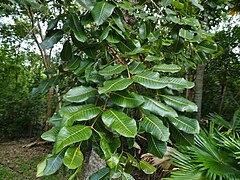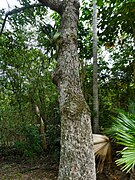Canarium australianum
| Scrub turpentine | |
|---|---|

| |
| Fruit and foliage | |
| Scientific classification | |
| Kingdom: | Plantae |
| Clade: | Tracheophytes |
| Clade: | Angiosperms |
| Clade: | Eudicots |
| Clade: | Rosids |
| Order: | Sapindales |
| Family: | Burseraceae |
| Genus: | Canarium |
| Species: | C. australianum
|
| Binomial name | |
| Canarium australianum | |
| Synonyms[2][3] | |
| |
Canarium australianum, commonly known as scrub turpentine, is a species of tree in the family Burseraceae native to Australia and Papua New Guinea. Other common names include mango bark, carrot wood, parsnip wood, Melville Island white beech and brown cudgerie.[2][4][5]
Description
Canarium australianum is a tree growing up to 30 m (98 ft) tall. The trunk has a rough grey bark and it may be buttressed. The large compound leaves can reach 37 cm (15 in) in length with between 7 and 15 leaflets that usually measure about 14 by 5 cm (5.5 by 2.0 in), sometimes larger. The leaflets are normally glabrous; the midrib and lateral veins are raised on the upper surface, and have a distinctive pale yellow colour.[6][4][5]
The inflorescences are panicles about 25–30 cm (9.8–11.8 in) long produced from the leaf axils. Flowers are fragrant and have 3 pale green or cream petals measuring about 4–6 mm (0.16–0.24 in) long. This species is dioecious, meaning that pistillate (functionally female) and staminate (functionally male) flowers are borne on separate plants.[6][4][5]
The fruit is a dark blue or grey, ovoid drupe measuring 2–3 cm (0.79–1.18 in) long and containing a single seed.[6][4][5]
Taxonomy
This species was first described by the Victorian state botanist Ferdinand von Mueller, based on material supplied to him from the Burdekin River by Eugene Fitzalan, and by Mr Henne who collected specimens from Sweers and Bentinck Islands in the Gulf of Carpentaria. It was published in Mueller's book Fragmenta phytographiæ Australiæ in 1862.[7]
Subspecies
Three varieties are recognised:[3]
- C. australianum var. australianum F.Muell.
- C. australianum var. glabrum Leenh. — styptic tree, jalgir (Bardi language) — type specimen from Bickerton Island in the Gulf of Carpentaria[8]
- C. australianum var. velutinum Hewson —jalgir (Bardi language) — type specimen from Cape Domett, north of Kununurra, Western Australia[9]
Distribution and habitat
The scrub turpentine is widely distributed across northern Australia from the Kimberley region of Western Australia, through the Northern Territory to eastern Queensland, where it is found from the Torres Strait Islands southwards almost as far as Mackay.[10] It also occurs in New Guinea.[4][6] It inhabits rainforest, monsoon forest and open forests at altitudes from near sea level to about 700 m (2,300 ft).[4][5][6]
All three varieties are found in Australia, while only the varieties C.a. australianum and C.a. glabrum occur in New Guinea.[6][11]
Gallery
-
Seedling
-
Young sapling
-
Tree in Cairns Botanic Gardens
-
Foliage
-
Trunk
References
- ^ "Species profile—Canarium australianum". Queensland Department of Environment and Science. Queensland Government. 2022. Retrieved 26 April 2024.
- ^ a b c "Canarium australianum". Australian Plant Name Index (APNI). Centre for Australian National Biodiversity Research, Australian Government. Retrieved 26 April 2024.
- ^ a b c "Canarium australianum F.Muell". Plants of the World Online. Royal Botanic Gardens, Kew. 2024. Retrieved 26 April 2024.
- ^ a b c d e f F.A.Zich; B.P.M.Hyland; T.Whiffen; R.A.Kerrigan (2020). "Canarium australianum". Australian Tropical Rainforest Plants Edition 8 (RFK8). Centre for Australian National Biodiversity Research (CANBR), Australian Government. Retrieved 3 June 2021.
- ^ a b c d e Cooper, Wendy; Cooper, William T. (June 2004). Fruits of the Australian Tropical Rainforest. Clifton Hill, Victoria, Australia: Nokomis Editions. p. 96. ISBN 978-0958174213.
- ^ a b c d e f Hewson, H.J. (2022). Kodela, P.G. (ed.). "Canarium australianum". Flora of Australia. Australian Biological Resources Study, Department of Climate Change, Energy, the Environment and Water: Canberra. Retrieved 26 April 2024.
- ^ Mueller, Ferdinand von (1862). Fragmenta phytographiæ Australiæ. Vol. 3. Melbourne: Joannis Ferres. p. 15. Retrieved 26 April 2024.
- ^ "Canarium australianum var. glabrum". Australian Plant Name Index (APNI). Centre for Australian National Biodiversity Research, Australian Government. Retrieved 26 April 2024.
- ^ "Canarium australianum var. velutinum". Australian Plant Name Index (APNI). Centre for Australian National Biodiversity Research, Australian Government. Retrieved 26 April 2024.
- ^ "Search: species: Canarium australianum | Occurrence records". Australasian Virtual Herbarium. Australian Government. Retrieved 26 April 2024.
- ^ Leenhouts, P.W. (1956). Steenis, C.G.G.J. van (ed.). Burseraceae. Vol. 5. Djakarta: Noordhoff-Kolff. Retrieved 25 April 2024.
External links
- Information about Canarium australianum from Townsville City Council's Natural Assets Database
- View a map of herbarium records of this species at the Australasian Virtual Herbarium
- View observations of this species on iNaturalist
- See images of this species on Flickriver.com




